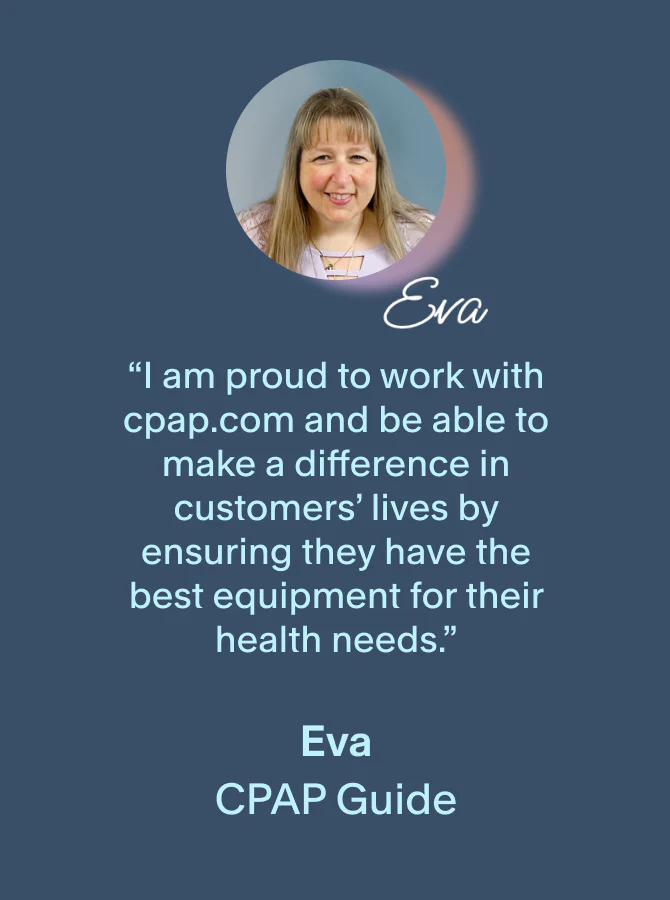Our content undergoes rigorous expert review, evidence-based research, and regular updates for accuracy.
Power outages are an inevitable part of life. If you don't have a reliable battery backup, you may be faced with sleeping without your CPAP machine, and skipping even one night of CPAP treatment can put your health at risk and impact your overall CPAP compliance.
Fortunately, CPAP battery backups offer peace of mind with uninterrupted power so you can continue enjoying the benefits of treating your sleep apnea with continuous positive airway pressure (CPAP).
Whether you're planning your next camping or RV trip, flying on an airplane, or preparing for mother nature, we’re here to help guide you to the best CPAP battery for you and your machine. We’ll teach you what to look for when shopping for your ideal CPAP battery, including:
- Types of CPAP Batteries
- Machine-Battery Compatibility Chart
- Best CPAP Batteries in 2024
- Choosing a Battery Size
- CPAP Battery Run Time
- How to Get the Most Out of Your CPAP Battery
- Which CPAP Batteries Are FAA-Approved
- CPAP Battery FAQs
Why is a CPAP Battery Backup Important?
Even if you’re not into hiking, camping, or going off the grid, it is still recommended to have a backup CPAP battery. Some CPAP batteries can be used as a backup that will kick in whenever there’s a sudden loss of power—ideal if you notice a storm in the forecast. In fact, the battery backup feature is why many people purchase additional or alternative batteries in the first place because you shouldn’t have to be without your therapy.
Can I Use a CPAP Battery Like a UPS Backup?
An uninterruptible power supply (UPS) is able to automatically detect a power outage and switch to battery power without any manual intervention. Some CPAP batteries do not function as a UPS backup, and will require you to disconnect your machine from the wall outlet and switch it to battery power in the event of a power outage.
Fortunately, for those worried about power outages, every battery on this list will function as a UPS except for the Zopec Voyage.
What’s the Best CPAP Battery Backup for Power Outages?
If you're looking for the best backup battery for your CPAP machine, we can confidently recommend any of the excellent options among Zopec's Explore Battery Series (NOT including the Zopec Voyage). Each battery in the Explore lineup has a dedicated AC outlet producing a pure sine wave power signal, which means they're universally compatible with any CPAP machine, even older, more power-sensitive models.
Each Explore battery has automatic switching technology that enables them to take over your therapy during a power outage without any input required. They also all feature fireproof exteriors, so if the battery ever malfunctions and catches fire, the fire will be contained within the battery's shell. Explore batteries don't use fans for cooling either, and there are no moving parts, which means these batteries are maintenance-free and won't get clogged with dust or suck in bacteria.
For even greater versatility and value, every Explore series battery includes a wall charger and a fast car charger!
Essentially, you can't go wrong with a Zopec Explore battery, and the larger capacity models can even support a humidifier and heated tube setup! Explore batteries can also be linked infinitely in a series to meet your power needs. So, whether you're looking for a battery that's FAA-approved for air travel, something you can camp with, or a robust option to use at home, you're sure to find something you like in Zopec's Explore series!
If you're looking for another option, the Portable Outlet Uninterruptible Power Supply is also ideal for a CPAP battery backup. If power is lost, it will automatically kick in, and your therapy won’t miss a beat. Thanks to its 110V AC outlet, you won’t need to worry about any adapters or converters to get your CPAP machine set up, either!
At a 159 Wh capacity, the Portable Outlet UPS Battery is also the largest capacity approved for air travel by the FAA and TSA, making it great for weekend getaways, too. Like Zopec's Explore series, the Portable Outlet UPS Battery produces a pure sine wave signal, meaning it's perfectly safe to use with an older machine, too.
Types of CPAP Batteries
When it comes to powering your CPAP machine off-grid, there are three main options: deep cycle batteries (commonly found on boats, golf carts, and mobility scooters), lithium-ion batteries (found in most modern electronics), and a relatively newer technology called Lithium-Iron Phosphate batteries.
- Deep cycle batteries are typically found in auto part stores, are much heavier than lithium-ion batteries, and require special equipment to recharge. As a general rule of thumb with deep cycle batteries, more weight = more power.
- Lithium-ion batteries are the most common CPAP batteries available today and are designed to provide a decent runtime—some can even power a CPAP machine for multiple full nights of therapy! They also typically charge quickly, reaching full power in four to six hours.
- Lithium-Iron-Phosphate (LiFePO4) batteries like the EXP PRO EXP48 and EXP96 batteries are very similar to lithium-ion batteries but use different internal chemistry to increase durability and longevity. Where lithium-ion batteries can only operate between 32° F and 104° F, LiFePO4 batteries can operate between -4° F and 132° F. Where lithium-ion batteries can only be recharged about 500 times before a new battery is needed, LiFePO4 batteries boast a lifecycle of 5,000 recharges. To top it off, LiFePO4 batteries are less prone to thermal runaway, making them a safer and more reliable bet for home use.
Here’s a quick breakdown of the three different types of CPAP batteries:
Deep Cycle:
- Limited Portability
- Setup is More Complicated/Involved
- Great for RV Camping
- Longer Battery Life
In order to connect to the deep cycle batteries, you can use an inverter. You’ll use alligator clips to connect to the positive and negative terminals, and then plug in your machine like you normally would.
It’s also possible to make a connection to the terminals with a normal cigarette-style outlet for machines that don’t need an inverter. You would then charge the battery using a DC cable.
If you’re looking for a light and simple option for a battery backup, we recommend a lithium-ion battery.
Lithium-Ion:
- Great Portability
- Use In-Flight
- Typically Plug-and-Play
- Quick Charge
- Great for Flying
In addition to this, you should also consider whether you’re interested in a battery solely for travel, a backup battery to protect you during power outages, or something that can do both.
Lithium-Iron Phosphate (LiFePO4):
- Better Thermal Performance
- Longer Overall Lifecycle
- Lower Environmental Impact
Simply put, LiFePO4 batteries are an evolution of lithium-ion batteries that are better suited to long, stable discharges, which makes them great for CPAP. They also handle temperature fluctuations better and have longer overall lifecycles. They are a bit heavier than lithium-ion batteries and may take a bit longer to charge, but your investment will go much farther with LiFePO4 batteries because they are rated for 10 times as many recharge cycles as lithium-ion batteries.
CPAP Machine Battery Compatibility
Best CPAP Batteries in 2024
Medistrom Pilot-24 Lite
The Medistrom Pilot-24 is a top-ranked CPAP battery thanks to its lightweight and compact design. It’s FAA compliant, meaning you can carry it on and use it during your flight.
The Medistrom Pilot-24 gained popularity because of its native compatibility with ResMed’s immensely popular AirSense 10 and AirMini CPAP machines. Not only can the Pilot-24 power your CPAP away from home, it can also act as a CPAP backup battery in the event of a power failure. It even features a USB port for charging mobile devices and a built-in LED flashlight!
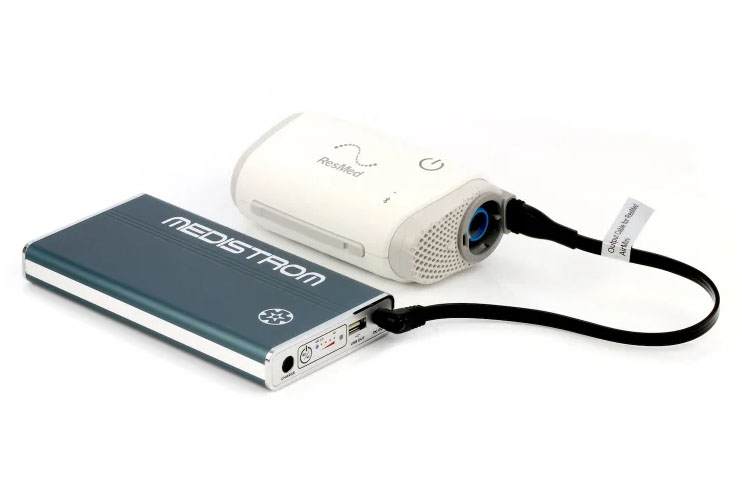
Additionally, separate cables can be purchased to make the Pilot-24 compatible with the 3B Medical Luna and Philips Respironics DreamStation Go.
Alternatively, the Medistrom Pilot-12 is also available for 12-volt machines. It is compatible with the following:
- DeVilbiss IntelliPAP & IntelliPAP 2 (With Optional Cables)
- HDM Z1 and Z2 Series Machines (With Optional Cables)
- Philips DreamStation (Except DreamStation Go)
Drawbacks: As a lithium-ion battery, the Pilot-24 can’t tolerate excessively hot temperatures for extended periods of time and will see reduced runtimes in colder climates. It may struggle to operate above 104° F for extended periods of time, meaning it may not be the ideal choice for camping or hiking in hotter climates. It also doesn’t come with its own power supply, which means if you want to charge it, you’ll need to use the power supply that came with your compatible machine. A final drawback specific to AirMini owners is that charging the Pilot-24 using the AirMini’s power adapter takes 7-9 hours for a full charge compared to a 2-3 hour charge time with the AirSense 10’s power adapter.
| Features | Specs |
|---|---|
| Power Cell Type | LG Lithium-Ion |
| Charge Capacity in Watt Hours | 95Wh |
| Rated Output | DC 24V, 3.75A |
| USB Out | 1 Port - 5V, 2.5A |
| Lifespan | 500+ Charge Cycles |
| Battery Indicator | Status Lights |
| Recharge Time | 2-3 Hours *7-9 w/AirMini Power Supply |
| Can It Function as a Backup Battery? | Yes |
| FAA Compliant | Yes |
| Weight | 1.3 lbs |
| Dimensions | 3.5" x 6.7" x 0.8" |
Portable Outlet UPS Battery
If you’re going where there’s no electrical outlet in sight, you’ll appreciate the convenience of the Portable Outlet UPS Battery. Thanks to a dedicated AC outlet producing a pure sine wave, you can power your CPAP machine, cell phone, laptop, or anything that uses a standard AC power supply, and it doesn't need any extra adaptors or connectors to recharge!
Speaking of standard power supplies, a really unique feature of the Portable Outlet UPS is that it uses a standard connection universal power cable to recharge, which is lightweight and doesn't have a bulky in-line power converter. This type of cable can be purchased at just about any electronics retailer, giving this battery an unparalleled level of convenience.
As a UPS battery, the Portable Outlet can also be set up as an uninterruptible power supply to keep your therapy going during a power outage. It features a 3.0A fast-charge USB port for powering a mobile device at the same time and a detailed color display.
One of the coolest features about the Portable Outlet UPS, however, is that it is an FSA/HSA eligible purchase! And, while many lithium-ion batteries struggle in hotter climates, the Portable Outlet is perfectly happy running between 105°F and 120°F thanks to a recent redesign focused on efficient cooling.
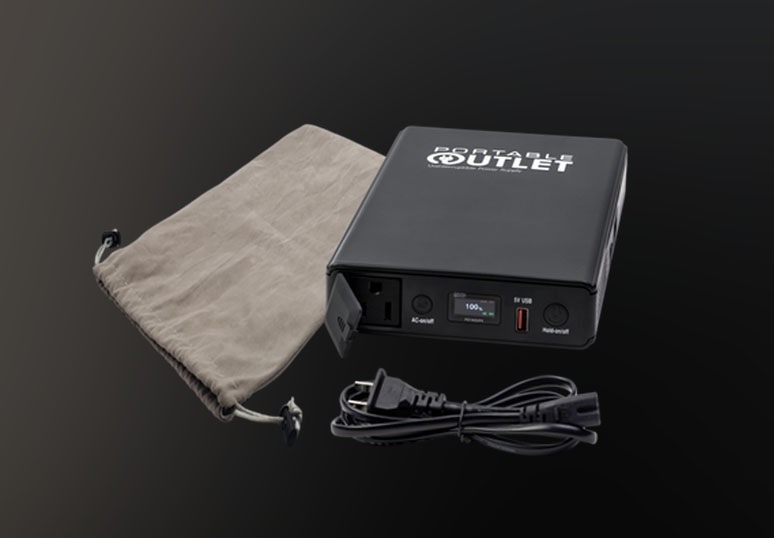
If you're looking to travel, this battery is right at the maximum capacity approved by the FAA and TSA for air travel, and it even includes a cloth carrying pouch. There's also an optional car charger available, as well as a solar panel charger to keep your battery running no matter where life takes you!
Drawbacks: As far as drawbacks go, there isn't much to say here. The Portable Outlet UPS Battery only offers one USB port, but it's a 3.0A rapid charge port—something many manufacturers don't incorporate. As a lithium-ion battery, it shouldn't be used in excessively hot temperatures for extended periods of time and will see a reduced runtime in especially cold environments.
| Features | Specs |
|---|---|
| Power Cell Type | LG Lithium-Ion |
| Charge Capacity in Watt Hours | 159Wh |
| Rated Output | AC 110V, 60Hz, 100W |
| USB Out | 1 Port - 5V, 3.0A |
| Lifespan | 500+ Charge Cycles |
| Battery Indicator | Digital Screen |
| Recharge Time | 4-5 Hours |
| Can It Function as a Backup Battery? | Yes |
| FAA Compliant | Yes |
| Weight | 2.9 lbs |
| Dimensions | 5-3/8” x 9” x 1.5” |
Shop the Portable Outlet UPS Battery Now
Zopec Explore Portable Series
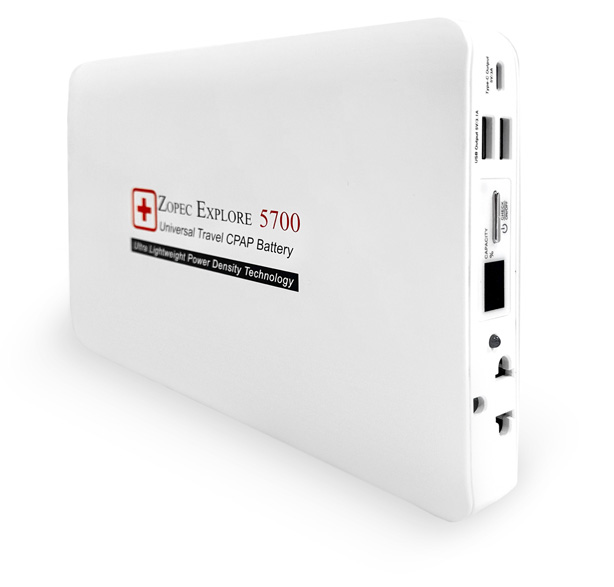
The main thing to know about this particular entry is that it’s not simply one battery we’re discussing, but two: the Zopec Explore 4000 and Zopec Explore 5700. These are effectively the same battery with different capacities and are part of Zopec’s “Portable Series”.
Both of these batteries function as a backup battery and will automatically switch when the power goes out. They also each have a dedicated AC outlet, a digital display capacity indicator, and two USB outlets for charging mobile devices. These batteries feature FAA-approved capacities of 130 Wh for the Explore 4000 and 160 Wh for the Explore 5700. The Portable Series batteries have a UPS protection rating of Silver, which means they’ll be able to take over your therapy when the power goes out as long as you’re not using a humidifier or heated tube.
All said and done, the Explore 4000 and Explore 5700 are great batteries for camping and hiking trips thanks to their light weight and versatility. Multiple Explore batteries, even those of different capacities, can also be linked in a series to easily scale with your power needs.
The Zopec Explore 4000 and 5700 batteries are compatible with all modern CPAP machines and most small appliances thanks to their dedicated AC outlets! These batteries produce a pure sine wave signal, so if you’re running an older machine that requires a pure sine wave, these batteries are a safe choice!
Drawbacks: Since the Explore series uses lithium-ion battery technology, none of them can tolerate excessively hot temperatures for extended periods of time. They also may struggle to operate above 104° F for extended periods of time, so they’re not well-suited for camping or hiking in hotter climates.
| Features | Explore 4000 | Explore 5700 |
|---|---|---|
| Power Cell Type | Panasonic Lithium-Ion | Panasonic Lithium-Ion |
| Charge Capacity in Watt Hours | 120Wh | 160Wh |
| Rated Output | AC 110V, 60Hz, 120W | AC 110V, 60Hz, 120W |
| USB Out | 2 Ports – 5V, 3.1A | 2 Ports – 5V, 3.1A |
| USB-C | 1 Port- 5V, 3A | 1 Port- 5V, 3A |
| Lifespan | 500+ Charge Cycles | 500+ Charge Cycles |
| Battery Indicator | Digital Display | Digital Display |
| Recharge Time | Under 4 Hours | Under 6 Hours |
| Can It Function as a Backup Battery? | Yes | Yes |
| FAA Compliant | Yes | Yes |
| Weight | 2 lbs | 2.5 lbs |
| Dimensions | 7.5″ x 5.5″ x 1.0″ | 8.5” x 6.0” x 1.0” |
Shop The Zopec Explore 4000 Shop The Zopec Explore 5700
Zopec Explore Professional Series
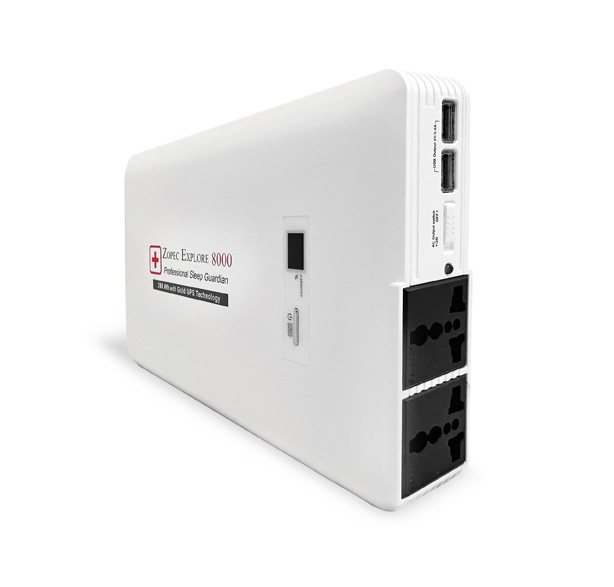
Continuing with the theme of Zopec Explore batteries, the next two batteries on our list belong to the more qualified “Professional Series” and feature some upgrades over the Explore 4000 and Explore 5700. In this case, the Explore 5500 and Explore 8000 feature a higher UPS protection rating of Gold, which means they’ll actually be able to take over when the power goes out even if you’re using a humidifier. Keep in mind, though, that humidifier usage significantly increases the battery draw and will reduce the time it can power your CPAP by about 60%.
The Explore 5500 and Explore 8000 both feature two dedicated AC outlets rather than one and relocated digital display, which has been moved from the side of the device to the top for easier viewing. The unique advantage of the Explore 5500 is that it’s FAA-approved for air travel, whereas the Explore 8000’s capacity far exceeds the limit outlined by the FAA.
And just like the Portable Series batteries listed above, multiple Explore batteries can be linked in a series to scale to your power needs, even if they don’t all have the same maximum capacity.
Just like their Portable Series cousins, the Zopec Explore 5500 and Explore 8000 Professional Series batteries are compatible with all modern CPAP machines and most small appliances thanks to their dedicated AC outlets! These batteries produce a pure sine wave, so if you’re running an older machine that requires a pure sine wave, these batteries are a safe option!
| Features | Explore 5500 | Explore 8000 |
|---|---|---|
| Power Cell Type | Panasonic Lithium-Ion | Panasonic Lithium-Ion |
| Charge Capacity in Watt Hours | 160Wh | 288Wh |
| Rated Output | AC 110V, 60Hz, 250W | AC 110V, 60Hz, 250W |
| USB Out | 2 Ports – 5V, 3.4A | 2 Ports – 5V, 3.4A |
| USB-C | 1 Port- 5V, 3A | 1 Port- 5V, 3A |
| Lifespan | 500+ Charge Cycles | 500+ Charge Cycles |
| Battery Indicator | Digital Display | Digital Display |
| Recharge Time | Under 6 Hours | Under 8 Hours |
| Can It Function as a Backup Battery? | Yes | Yes |
| FAA Compliant | Yes | No |
| Weight | 3 lbs | 4 lbs |
| Dimensions | 8.5” x 6.0” x 2.0” | 10.0” x 6.0” x 2.0” |
Shop the Zopec Explore 5500 Shop the Zopec Explore 8000
Zopec Explore Oxygen

Designed to provide backup power for a CPAP machine and oxygen concentrator simultaneously, the Zopec Explore Oxygen is essentially the biggest, baddest battery in the Explore series. Featuring two dedicated AC outlets, the Explore Oxygen boasts a mind-boggling 576 Wh capacity that can power your machine without a humidifier or heated tubing for up to 8 nights at a setting of 10 cmH2O.
What’s really special about the Explore Oxygen battery, however, is its Platinum-grade UPS protection rating. While other batteries would simply shut off in a power outage if you’re sleeping with your humidifier and heated tubing, the Explore Oxygen will seamlessly switch over and continue delivering therapy all night long. Other batteries can’t do this because of their lower UPS protection ratings, and this is the only Platinum-rated CPAP backup battery on this list.
It should come as no surprise that the Zopec Explore Oxygen is compatible with all modern CPAP machines and most small appliances. The Explore Oxygen produces a pure sine wave, so if you’re running an older machine that requires a pure sine wave, the Explore Oxygen is a safe choice.
Drawbacks: Certainly, the most apparent drawback of the Explore Oxygen is its size and weight. It’s not approved for air travel due to its massive capacity and has the same temperature guidelines as the other lithium-ion batteries on this list, though we don’t expect anyone to take this battery camping unless it’s for extended periods of time.
| Features | Explore Oxygen |
|---|---|
| Power Cell Type | Panasonic Lithium-Ion |
| Charge Capacity in Watt Hours | 576Wh |
| Rated Output | AC 110V, 60Hz, 250W |
| USB Out | 2 Ports – 5V, 3.4A |
| USB-C | 1 Port- 5V, 3A |
| Lifespan | 500+ Charge Cycles |
| Battery Indicator | Digital Display |
| Recharge Time | Under 12 Hours |
| Can It Function as a Backup Battery? | Yes |
| FAA Compliant | No |
| Weight | 7.5 lbs |
| Dimensions | 10.0” x 6.0” x 3.0” |
Shop the Zopec Explore Oxygen Battery Now
BPS Universal Freedom V2 Travel CPAP Battery
An upgrade on the original BPS Freedom CPAP Travel Battery, the Universal Freedom V2 Travel CPAP Battery Kit has a 20% longer battery runtime and leaves bulky adapters as a thing of the past. This battery kit includes a universal cable kit that works with nearly every CPAP machine, minus the HDM Z2 Auto. The Freedom V2 works with both 12V and 24V machines.
The Freedom V2 can charge in as little as two hours and allows your CPAP machine to run for one to three nights. It also features a digital display screen to keep track of your charge levels and is FAA and TSA-approved for air travel.
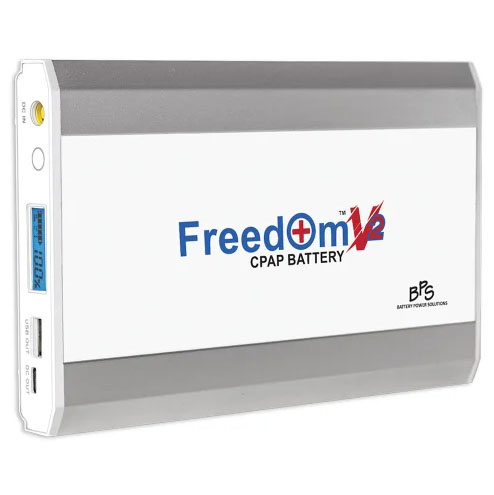
The Universal Freedom V2 is compatible with:
- AirSense 11
- 10-Series AirSense, AirCurve, or AirStart Machines
- DreamStation Series Machines
- AirMini
- ResMed S9
Drawbacks: The Universal Freedom V2 does not feature a full-sized AC outlet like other battery packs, such as the Portable Outlet, and has limited compatibility. As a lithium-ion battery, the Freedom V2 can’t tolerate prolonged exposure to excessive heat or cold. It may struggle to operate above 104°F for extended periods of time, meaning it may not be the ideal choice for camping or hiking in hotter climates.
| Features | Specs |
|---|---|
| Power Cell Type | LG/Samsung Lithium-Ion |
| Charge Capacity in Watt Hours | 99.9Wh |
| Rated Output | DC 12-24V, 8A |
| USB Out | 1 Port - 5V, 2.4A |
| Lifespan | 500+ Charge Cycles |
| Battery Indicator | Digital Screen |
| Recharge Time | 2-3 hrs @ 90W I 3-4 hrs @ 60W I 8-9 hrs @ 20W |
| Can It Function as a Backup Battery? | Yes |
| FAA Compliant | Yes |
| Weight | 1.7 lbs |
| Dimensions | 4.8" x 7.5" x 0.8" |
Shop the Universal Freedom V2 Travel Battery Now
EXP96 Pro Lithium Iron Phosphate Battery Bank
Easily the longest-lasting CPAP battery on this list, the EXP96 Pro advertises up to six full nights of CPAP use off-grid! While that number comes from testing without heated tubing or humidification, the EXP96 should still deliver at least two full nights of therapy for most machines, even at 14-16 cm H2O.
The EXP96 Pro has two USB ports and one USB Type-C port for keeping up with your mobile devices at the same time as your CPAP therapy. Instead of using lithium-ion cells, the EXP96 Pro utilizes lithium-iron-phosphate technology resulting in a battery with a ten-times-longer lifespan and higher tolerance for temperature fluctuations than lithium-ion batteries. It can power your devices anywhere between -4° F and 132° F and is not inherently flammable like lithium-ion batteries.
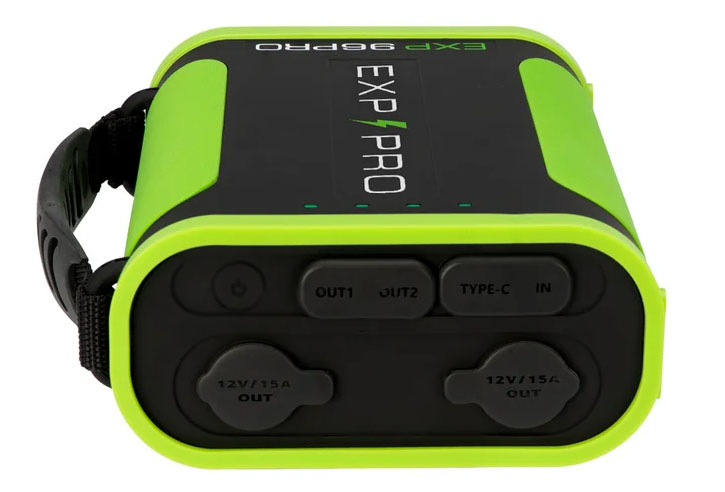
The EXP96 Pro is compatible with:
- AirSense 11 (With AS11 DC Adapter)
- AirMini
- AirSense 10
- AirCurve
- AirStart
- DreamStation Auto
- System One
- HDM Z1 and Z2
- IntelliPAP
- Transcend
Drawbacks: You will need to have your specific device’s DC cables to recharge or an inverter if using a machine that requires AC power. The EXP96 Pro is not FAA-approved, as it exceeds the maximum 160-watt-hour capacity requirement laid out by FAA regulations. It is also the heaviest CPAP battery on this list.
| Features | Specs |
|---|---|
| Power Cell Type | Lithium-Iron-Phosphate |
| Charge Capacity in Watt Hours | 307.2Wh |
| Rated Output | DC 12-24 V |
| USB Out | 2 Ports - 5V, 2.4A & 3.6-12V, 1.5-3.0A1 USB-C Port |
| Lifespan | 5000+ Charge Cycles |
| Battery Indicator | Status Lights |
| Recharge Time | 10-12 Hours |
| Can It Function as a Backup Battery? | Yes |
| FAA Compliant | No |
| Weight | 6.5 lbs |
| Dimensions | 6" x 8.2" x 3" |
EXP48 Pro Lithium Iron Phosphate Battery Bank
For up to four nights, you can keep your CPAP machine running on the go with one charge thanks to the EXP48 Pro. The EXP48 Pro is approved for in-flight use and is powered by the same lithium-iron-phosphate technology as the EXP96 Pro.
With the inclusion of one USB-C port and two USB charging ports, one of which is rapid-charge capable, you’ll be able to power up to three additional devices in addition to your CPAP machine! It also has built-in rubber plugs and a durable outer shell, perfect for flying and other travel plans.
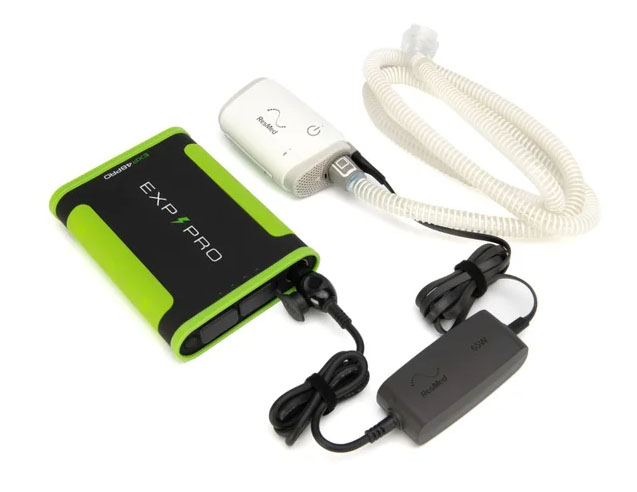
The EXP48 Pro is compatible with:
- AirSense 11 (With AS11 DC Adapter)
- AirMini
- AirSense 10
- AirCurve
- AirStart
- DreamStation Auto
- HDM Z1 and Z2
- IntelliPAP
- Transcend
Drawbacks: Like the EXP96 Pro, you will need to have your machine-specific DC charger. It is also the second-heaviest battery on this list.
| Features | Specs |
|---|---|
| Power Cell Type | Lithium-Iron-Phosphate |
| Charge Capacity in Watt Hours | 154Wh |
| Rated Output | DC 12-24 V |
| USB Out | 2 Ports - 5V, 2.4A & 3.6-12V, 1.5-3.0A1 USB-C Port |
| Lifespan | 5000+ Charge Cycles |
| Battery Indicator | Status Lights |
| Recharge Time | 4-6 Hours |
| Can It Function as a Backup Battery? | Yes |
| FAA Compliant | Yes |
| Weight | 3.3 lbs |
| Dimensions | 6" x 8.2" x 1.6" |
Zopec Voyage
The Zopec Voyage charges in four hours and can provide a night of battery-powered CPAP therapy for most machines at up to 15 cm H2O with the humidifier and heated tubing turned off.
While it isn’t the longest-lasting CPAP battery, it is very versatile thanks to its standard AC outlet, USB-C port, and two standard USB ports for charging mobile devices. The Voyage can charge or power anything that uses a standard AC power supply, including appliances, game consoles, televisions, and more.
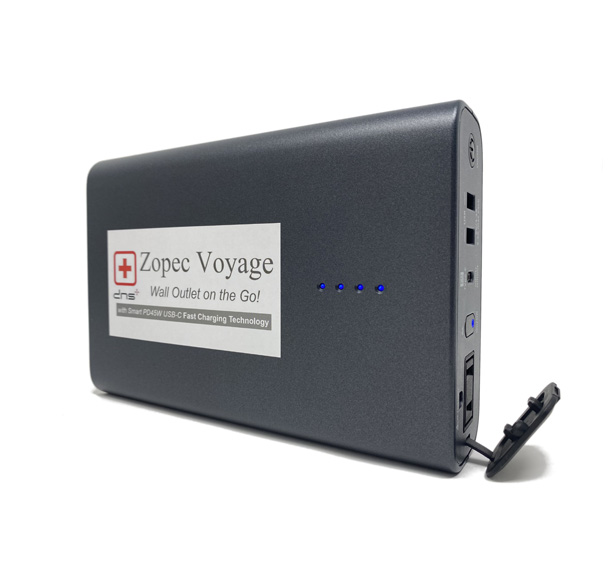
The Zopec Voyage is compatible with all modern CPAP machines and most small appliances thanks to its dedicated AC outlet. The Voyage produces a modified sine wave, so if you’re running an older machine that requires a pure sine wave, it will not run as smoothly on this battery and can cause wear on your machine over time.
Drawbacks: As a lithium-ion battery, the Zopec Voyage can’t tolerate excessively hot temperatures for extended periods of time. It may struggle to operate above 104°F for extended periods, meaning it may not be the ideal choice for camping or hiking in hotter climates. It is also the only battery on this list that does not have UPS functionality and cannot be used as a backup battery without manually switching to battery power during an outage.
| Features | Specs |
|---|---|
| Power Cell Type | Panasonic Lithium-Ion |
| Charge Capacity in Watt Hours | 150Wh |
| Rated Output | AC 110V, 60Hz, 80W |
| USB Out | 2 Ports - 5V, 2.1A1 USB-C Port |
| Lifespan | 500+ Charge Cycles |
| Battery Indicator | Status Lights |
| Recharge Time | Under 4 Hours |
| Can It Function as a Backup Battery? | No |
| FAA Compliant | Yes |
| Weight | 2 lbs |
| Dimensions | 5" x 7" x 1.5" |
What Size Battery Do I Need for My CPAP?
Outside of compatibility with your machine, the single most important aspect of any battery purchase is its capacity. Battery capacity is measured in watt-hours (Wh) and how far you can stretch those watt-hours depends on your machine as well as your pressure and comfort settings.
Most CPAP machines will draw 30-60 watts on a pressure setting of 5-10 cm H2O without a humidifier or heated tube, but peak power consumption can go as high as 90-110 watts for a machine running a humidifier at a higher pressure setting.
Simply put, one watt-hour of energy would be consumed if your CPAP machine operated at one watt for one hour. Looking at a real example, let’s take the Medistrom Pilot-24, which has a capacity of 99.9Wh, and the ResMed AirMini, which operates at an average draw of 6.3W.
After dividing the 99.9Wh capacity by the average draw of 6.3 watts per hour, we see that the Medistrom Pilot-24 could power an AirMini for 15.8 hours before needing a recharge—assuming the power draw remains at 6.3W the whole time. Please note, though, that this is only a general rule of thumb and can be affected by many of the variables we’ve already mentioned, in addition to whether the battery is suppplying AC or DC power. Travel CPAP machines are also significantly more energy efficient than their full-sized counterparts.
Also worth noting is that if you plan to travel by air with your new battery you’ll be limited to a capacity of 160Wh per FAA and TSA guidelines. However, if you plan to use your battery as a backup power source, you’ll want the largest capacity battery you can reasonably afford.
Battery Run Time
Most lithium-ion CPAP batteries are designed to last at least one night per charge, though some can handle two or more nights. However, battery runtimes can vary depending on:
- Machine Type/Age
- Pressure Setting
- Humidification Use
- Altitude Level
- Inverter Use
Because there are so many variables that can affect the run time of your CPAP machine on battery power, we recommend spending 1-2 weeks powering your CPAP machine solely from your new CPAP battery before you ever need to rely on it away from home.
This will help you set reasonable expectations for the battery and allow you to dial in exactly how much humidity you can get away with without draining your battery before the night is done. It’ll also give you a good idea of how long it takes to recharge your battery.
How to Achieve Longer Battery Run Times
If you’re able to, there are a few things you can sacrifice to improve the runtime you’ll get out of your battery. Camping with your CPAP or running on backup power may not always be the most comfortable experience, and for the best results, you may need to:
- Forego Humidification
- Use a Standard, Non-Heated Hose
- Avoid Using an Inverter if Possible
- Use an APAP Machine (Can Reduce Battery Load by Using the Lowest Necessary Pressure)
A travel CPAP machine will typically perform much better on a CPAP battery than a full-sized machine. It may also help to use a machine-specific battery instead of a universal battery if your manufacturer makes one. A good example of this would be the Extended Life Battery for the Z1 and Z2 Travel CPAP Machine or the Resmed Power Station II for the ResMed S9, AirSense 10, and AirCurve 10.
The most significant impact on your battery run time will be whether you choose to use your humidifier and heated tube (if you have one). Below is an estimate of how battery life changes depending on these factors (based on the 160 Wh Zopec Explore 5500 battery):
| AirSense 10 | DreamStation | |
| No Humidifier or Heated Tube | 16 Hours | 21 Hours |
| Humidifier on Medium, No Heated Tube | 8 Hours | 6 Hours |
| Humidifier and Heated Tube on Medium | 4 Hours | 4 Hours |
Are CPAP Batteries FAA Compliant?
For frequent travelers, we have great news! Many CPAP batteries are approved for in-flight use and can be used to safely power your CPAP machine while you travel to your next destination. Many of the batteries are lightweight and ultra-portable so fitting them inside your carry-on bag will be a breeze.
You can finally sleep on even your longest flights and get to your destination feeling refreshed and awake. If you fly often, a travel CPAP machine may also be useful for your adventures.
FAA and TSA Guidelines for Lithium-Ion Batteries:
Per TSA and FAA guidelines, lithium-ion batteries, such as CPAP batteries, must be stored in carry-on baggage only and are prohibited in checked luggage. Exposed battery terminals must also be covered and protected from direct contact with any other metal to prevent an accidental short-circuit.
There is no technical limit to the number of lithium-ion batteries you can pack in your carry-on so long as no single battery exceeds a capacity of 100Wh and the batteries are for personal use and not for resale or distribution. You may also pack up to two spare high-capacity batteries with a maximum capacity of 160Wh per battery, though the FAA states that these spare batteries are only allowed at the discretion of your airline. Thankfully, every major US airline allows for these high-capacity spare batteries at the time of this writing, including Delta, United, American Airlines, and Southwest.
Which CPAP Batteries Are FAA Approved for In-Flight Use?
One of the most popular FAA-approved lithium-ion batteries is the Medistrom Pilot-24 Lite. It’s one of the lightest CPAP batteries around and is compatible with many popular CPAP machines. Lithium-ion batteries are the go-to when it comes to in-flight use, and the only batteries on this list that actually aren’t FAA-approved are the EXP96 Pro, Zopec Explore 8000, and Zopec Explore Oxygen due simply to their large capacities, which exceed 160 Wh.
Commonly Asked Questions About CPAP Batteries
Can You Rent a CPAP Battery?
Yes, some storefront DMEs may offer a battery rental service if you’re looking for a local option, but there are also websites that specialize in rentals for CPAP batteries at reasonable prices. The same is true for deep-cycle batteries.
Does Medicare or Other Insurance Pay for CPAP Battery Backup?
What CPAP Machines Have a Built-In Battery? Do CPAP Machines Come With a Battery Backup?
Unfortunately, no CPAP machines include a backup battery or have one built-in.
Are CPAP Batteries FSA Eligible?
Yes, CPAP batteries can be reimbursed using FSA or HSA funds.
How Much Does a CPAP Battery Typically Cost?
When shopping for a CPAP battery, you can expect to spend anywhere between $250 and $1,000, depending on capacity and machine compatibility. To get the most out of your purchase, we recommend a universal battery like the Portable Outlet UPS Battery or a Zopec Explore series battery, as they feature standard AC outlets capable of powering just about anything you can plug into it.
Final Thoughts
We hope this guide was helpful in preparing you to choose the best CPAP battery for your machine or next adventure!
Don’t forget to thoroughly test and understand your new battery in the comfort of your home well in advance of any travel plans you plan to take it on. Be aware of the temperature restrictions of your battery and FAA guidelines if flying. Lastly, make sure you have any special cables or adapters your CPAP/battery combo may require as well.
Universal batteries like the Portable Outlet and Zopec Voyage are a great choice for their versatility, but machine-specific batteries may be better-optimized for power consumption, so be sure to explore your options before purchasing.
Whether you’re hitting the trail or opting for a battery backup, you can’t go wrong by having a CPAP battery on hand and ready to go!






